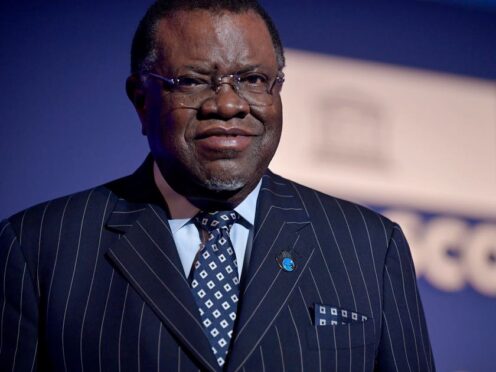
Namibian President Hage Geingob has died while receiving medical treatment, his office has announced.
The Namibian presidency said Mr Geingob’s medical team at Lady Pohamba Hospital did its best to help him, but he died with his wife, Monica Geingos, and children by his side.
He had been president since 2015 and was set to finish his second and final term in office this year.
His deputy, vice-president Nangolo Mbumba, has now been sworn in as acting president to complete the term, as allowed by the constitution.
Elections are set for November. A government statement said Mr Mbumba will lead Namibia until March 21 next year, when the election winner takes office.
Mr Geingob was undergoing treatment for cancer. The 82-year-old had a colonoscopy and a gastroscopy on January 8, followed by a biopsy, his office said last month.

He returned home on January 31 from the United States, where he had undergone a two-day trial of “novel treatment for cancerous cells”, according to his office. In 2014, he said he had survived prostate cancer.
Mr Geingob was the country’s third president since it gained independence in 1990, following more than a century of German and then apartheid South African rule.
After spending nearly three decades in exile in neighbouring Botswana and the US as an anti-apartheid activist, Mr Geingob returned to Namibia as its first prime minister from 1990 to 2002. He also served in the same capacity from 2008 to 2012.
Soft-spoken but firm on advancing Africa’s agenda as an important stakeholder in world affairs, Mr Geingob maintained close relations with the US and other Western countries.
But, like many African leaders, he also forged a warm relationship with China, refuting claims that Beijing is aggressively asserting economic influence over countries in Africa as a form of colonialism.
Announcement of the Passing of H.E Dr @hagegeingob, President of the Republic of Namibia, 04 February 2024
Fellow Namibians,
It is with utmost sadness and regret that I inform you that our beloved Dr. Hage G. Geingob, the President of the Republic of Namibia has passed on… pic.twitter.com/Qb2t6M5nHi
— Namibian Presidency (@NamPresidency) February 4, 2024
Namibia, which is on the south-western coast of Africa, enjoys political and economic stability in a region ravaged by disputes, violent elections and coups. However, the country’s opposition slammed Mr Geingob last year for endorsing disputed elections in Zimbabwe.
Condolences from various African leaders poured in on Sunday.
Zimbabwe’s President Emmerson Mnangagwa posted on X, saying Mr Geingob’s “leadership and resilience will be remembered”.
Cyril Ramaphosa, president of neighbouring South Africa and one of Namibia’s largest trading partners, described him as a “close partner in our democratic dispensation” and “a towering veteran of Namibia’s liberation from colonialism and apartheid”.
Kenya’s Prime Minister William Ruto said Mr Geingob was a “distinguished leader who served the people of Namibia with focus and dedication” and “strongly promoted the continent’s voice and visibility at the global arena”.
In a statement, Russian President Vladimir Putin said he would “forever cherish” his memories of meeting Mr Geingob. “It is difficult to overestimate his personal contribution to developing friendly relations between Namibia and Russia.”
Namibia, a country of just over 2.5 million people, is rich in minerals such as diamonds, gold and uranium. Despite being classified as an upper-middle-income country, socioeconomic inequalities are still widespread, according to the World Bank.

Enjoy the convenience of having The Sunday Post delivered as a digital ePaper straight to your smartphone, tablet or computer.
Subscribe for only £5.49 a month and enjoy all the benefits of the printed paper as a digital replica.
Subscribe